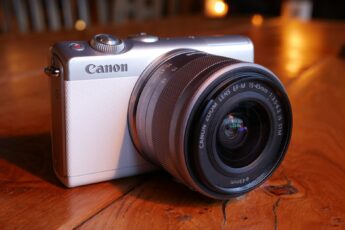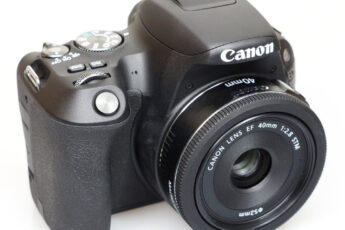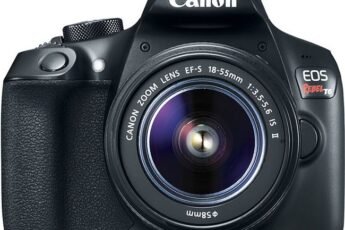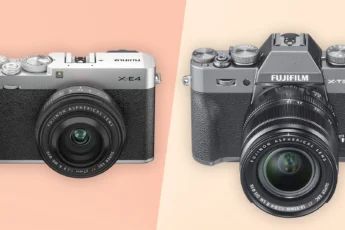Are you ready to purchase this mirrorless marvel?
- Technical Specifications
- Build Quality
- Image Quality
- What additional features does the Canon EOS M6 have?
- How does the Canon EOS M6 compare to the Canon EOS M100?
- Advantages of the Canon EOS M6
- Advantages of the Canon EOS M100
- How does the Canon EOS M3 compare to the Canon EOS M6?
- Who is the Canon EOS M6 for?
- Conclusion
Technical Specifications
- Price: $479.00 body-only, $599.00 with kit lens
- Kit Lens: EF-M 15-45mm f/3.5-6.3 IS STM. EF-M is a mirrorless Canon lens. IS describes the in-lens Image Stabilization. STM refers to the “Stepper Motor,” which is the autofocus motor type.
- Sensor: 24.2 MP sensor (APS-C sized 22.3 x 14.9 mm)
- Number of Autofocus Points: 49 Phase detection AF points. Phase Detection uses paired sensors to detect the differences in light reaching them from the subject. The lens can then be adjusted to focus properly.
- Built-In Flash: Yes; 5.0 m (16.4 ft.) range at ISO 100. ISO 100 is the lowest level of light sensitivity. With higher ISO values, the flash detection range increases.
- Continuous Shooting: 9 frames per second, down to 7 fps with Servo AF. “Servo” is usually called “Continuous” autofocus by other brands.
- ISO Range: 100-25,600
- Video Recording Capability: Full HD 1920×1080 (60, 30, 24 fps), HD 1280×720 (60 fps), SD 640×480 (30 fps)
- Image Format: JPEG and RAW. JPEG is the image format used by most devices for display. JPEG is a compressed format designed to take up less space in device memory. RAW format is higher quality because it contains all of the camera’s image data. They are uncompressed files, so they take up much more space. But for image editing with the right software, RAW files are superior to JPEG files.
- Wireless Connectivity: Yes; Wi-Fi, Bluetooth, and NFC (Near Field Communication). The camera can be remote controlled using the Canon Connect App available for Android and iOS. The app can also be used to send photos from the camera to a smart device for easy sharing. The NFC connection allows for fast pairing to Android devices and Canon’s Connect Station CS100. The Connect Station is a wireless storage device that holds up to 1TB of data.
- Supported Memory Cards: SD, SDHC, SDXC, UHS-I
- Battery Life (CIPA Rating): 295 images per charge
- Weight: 390 g (0.86 lb / 13.76 oz)
- Dimensions: 112 x 68 x 45 mm (4.41 x 2.68 x 1.77 in)
Build Quality
With a composite metal and plastic body, the Canon EOS M6 has a fairly durable design. The textured plastic across the handgrip and front of the camera gives a firm, comfortable grip. Unlike other Canon mirrorless models, the M6 has both a flash unit and a hot shoe for an additional unit. However, it does not have an electronic viewfinder. All photos and video must be composed using the 1,040,000 pixel LCD display. For photographers used to looking through a viewfinder, this might be a deal breaker. However, the M6’s hot shoe unit means an EVF can also be purchased separately and installed on the camera.
The EOS M6 has a very well laid out series of dials for instant setting adjustments. It has the usual mode dial for Scene selection, video recording, Manual, shutter speed (TV), and aperture (AV) priority modes. The dedicated exposure compensation dial is handy for instant brightness adjustment without having to navigate camera menus. When you don’t want to adjust shutter speed, aperture, or ISO for creative purposes, exposure compensation gives you similar results. The M6 also has three fully customizable dials for maximum convenience. The first is the main dial which surrounds the shutter. A second quick control dial sits just under the exposure compensation dial. And on the back of the camera, is a third controller wheel. Compared to the simplified button layout of the Canon EOS M100, the M6 offers more flexibility for advanced users.
The M6 has a slight issue when the camera is being used to take a selfie. If the LCD screen is tilted up so the shooter can see the image while shooting, a few millimeters of the LCD’s bottom edge are hidden by the camera’s body. As a result, part of the touchscreen is hidden while taking selfies. It’s a pretty minor design flaw, but it’s worth noting.

Image Quality
Canon’s mirrorless line uses large APS-C sensors (sized 22.3 x 14.9 mm) with higher megapixel counts than many other mirrorless brands. Fujifilm and Sony also use 24 MP APS-C sensors with many of their products. But Nikon, Olympus, and Panasonic usually use 16-20 MP sensors for their beginner to intermediate cameras. The sensors are also smaller than APS-C. This gives the M6 an edge in image quality.
Larger sensors give greater depth of field control and low light performance. Depth of field is how much of a scene is in sharp focus. And being able to narrow that focus to exactly where you want is easier with large sensors. Only full-frame sensors (sized 36 x 24 mm) are larger. Large sensors also have a larger surface area to collect light. As a result, image noise is less of an issue when the light levels are less than perfect. 24.2 megapixels is average in the camera market today, but that’s more than enough for most users. 24.2 MP is enough for 300 pixel per inch uncropped prints up to 13 x 20 inches in size. And it gives a comfortable amount of space for cropping photos without losing too much image quality.
The EOS M6 also has a low-pass (anti-aliasing) filter, which is useful if the photographer is worried about moiré patterns. Moiré are errors in photos that have closely knit repeating patterns, like closeups of feathers or the weave of fabric. The patterns will unnaturally blur together in certain areas. For photographers that take photos with these subjects often, the low-pass filter of the M6 is a handy tool. But low-pass filters do decrease the resolution of the camera sensor slightly, resulting in a slight loss of sharpness in photos.

What additional features does the Canon EOS M6 have?
The uses a Dual Pixel autofocus system with 49 selectable AF points. Dual Pixel is different from the Hybrid CMOS AF III system used by its predecessor, the Canon EOS M3. Dual Pixel is a phase detection based autofocus system. It detects differences in the light reaching each pair of phase detection autofocus points. The light detected by the pairs can be analyzed to determine focusing distance to the target.
The M3 has a secondary contrast detection system as well as phase detection elements. Contrast detection senses differences in image contrast to find maximum sharpness. Phase detection is faster, but less accurate than contrast detection. So combining the two gives a good balance of autofocus speed and accuracy. Hybrid autofocus is increasingly common in mirrorless cameras nowadays. But the EOS M6 is geared entirely for AF speed with its design. Combined with its DIGIC 7 processor, capable of up to 9 fps continuous shooting, the M6 is excellent for action photography.
Manual focusing with the EOS M6 is a pleasure, thanks to the focus peaking feature. When looking at the LCD screen, focus peaking adds color highlights to the portions of a scene that are in sharp focus. Sometimes when looking through a viewfinder, the image appears to be focused precisely, but the final photo is not. With focus peaking, you can target the exact location you desire, such as the eyes when shooting portraits.
Canon’s mirrorless image stabilization has been slow in development. Most of the lower priced models only offer digital IS when shooting video. Image stabilization is used to reduce or eliminate blur from motions such as hand shake. Any image stabilization is always better than none at all. But video-only digital IS is a far cry from the impressive sensor stabilizers Olympus, Panasonic, and Sony use with their mirrorless lines. Fortunately, the M6 shows Canon is looking to improve their mirrorless IS systems as well with its new Combination IS. Combination IS makes use of the in-lens image stabilizers many Canon DSLR and mirrorless lenses have integrated. They work together with the digital IS system to create image stabilization for both still images and video recording. Because it uses additional battery power, it can be disabled when shooting with a tripod.
The EOS M6 has two excellent lighting and contrast adjustment tools. Auto Lighting Optimizer is used to adjust color contrast and brightness, keeping images from becoming too dark and lacking contrast. The effect can be subtle with the Low setting, or adjusted even higher than needed. Highlight Tone Priority is another tool and can be used when shooting in bright lighting. The camera softens the change from normal to bright lighting. By making brightly lit areas less harsh, it brings back details that would otherwise be lost in the glare. Highlight Tone Priority mode can only be used with ISO 200 or less, and not with Auto Lighting Optimizer.
The M6 also has the popular High Dynamic Range (HDR) photography option. HDR photography is meant to be used with a tripod and on still subjects only. Three photos are taken in total. The first is a baseline with normal exposure. The second adjusts the exposure to be brighter than the first. And the third has the exposure adjusted to be darker than the first. The three are used to create a composite photo with full detail found in both brightly lit areas and darker shadows.
Like the rest of the EOS M line, the M6 also has Multishot Noise Reduction. MNR is designed to make higher ISO values more useful. Using the highest ISO sensitivity settings usually results in photos with large amounts of noise that leaves them unusable. MNR takes four images and then sifts through the extra information for the best signals to use in the final image. Having four baselines allows MNR to greatly reduce the amount of noise the photo contains, making higher ISO values much more useful. However, because the camera takes four photos with a slight time delay, shooting a moving subject may result in a blurry image. Multishot Noise Reduction is best used for slow moving subjects in dim lighting and with a tripod or Combination IS.
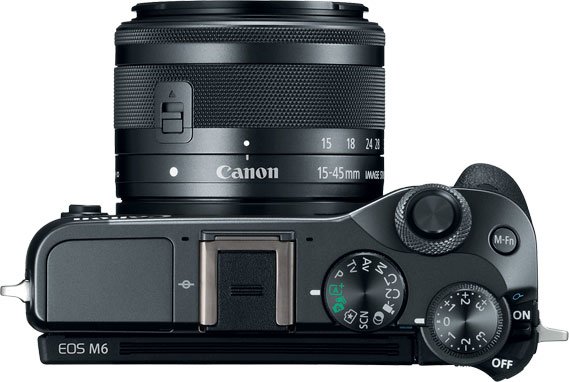
How does the Canon EOS M6 compare to the Canon EOS M100?
The Canon EOS M6 and Canon EOS M100 are Canon’s newest additions to its mirrorless camera line. Both have a suite of excellent features and solid base statistics. Side-by-side, how do they compare?
Advantages of the Canon EOS M6
Extra controls: This is somewhat of a toss-up, as the simplified design of the M100 is a feature for many users. The M6 has a dedicated exposure compensation dial for instant brightness correction. And the mode dial also has aperture (AV) and shutter (TV) priority mode, along with the usual Scene and video selections. The M100 has these, but instead of being on the mode dial, they are found in the camera menus. The mode dial only has Auto, a generalist “manual” button, and video recording. For someone who prefers a basic layout and doesn’t mind navigating menus when required, the M100 is a good choice. But many users are already familiar with the layout of DSLR and mirrorless cameras. Most photographers will find the M6 more comfortable to operate.
Continuous drive: At 9 frames per second, the M6 takes photos slightly faster than the M100 (6 fps). For photographers looking to shoot fast paced action, the M6 is the better choice.
Image Stabilization: The M6 has image stabilization that works with still photos as well as video. Combination IS does require using compatible Canon mirrorless lenses. But it’s still superior to the digital video-only IS system of the M100.
Advantages of the Canon EOS M100
Price: With a price of $399.00 with kit lens, the M100 is much cheaper than the M6 at $599.00, and still takes excellent photos.
Weight: The M100 at 302 g (0.67 lb / 10.65 oz) is lighter than the M6 at 390 g (0.86 lb / 13.76 oz). Dimensions-wise, the two cameras are compact and nearly identical.
The EOS M6 is clearly geared towards an intermediate market as well as beginners more confident in learning the layout. Beginners may find the M100 easy to operate. But the menu system of accessing basic functions like aperture and shutter priority will get old fast. The M6 is still suitable for beginner photographers, but the price difference is hard to ignore. Image quality-wise, the two cameras are identical. If a standard button and menu design, and image stabilization are important to you, then the M6 is the better choice.
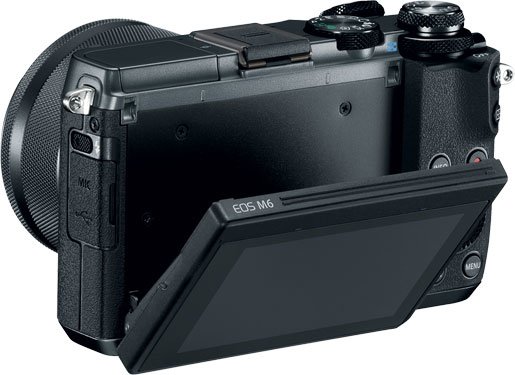
How does the Canon EOS M3 compare to the Canon EOS M6?
Both cameras have 24.2 MP APS-C sensors, 49 AF points, and a compact mirrorless frame. But the M6 does improve on the M3 in a number of ways. The battery life of the M6 is improved; taking 295 pictures over 250 for the M3. Also, the M3’s maximum native ISO value is 12,800 (with a digital boost to 25,600). The M6 has a maximum native ISO of 25,600, which is better for low light performance. Digital ISO boosts are software edits of photos designed to mimic ISO values beyond the sensor’s performance. But digital boosts are never as good as having the actual ISO value. And with the Multishot Noise Reduction of Canon’s M line, higher ISO values are actually usable.
The autofocus systems of the two cameras are different as well. The Dual Pixel design of the M6 is faster but less accurate than that of the M3. The M3 combines both phase and contrast detection, which is somewhat slower. Macro and portrait photographers will appreciate the extra accuracy over speed. But the M6, with phase detection and the DIGIC 7 processor, can shoot up to 9 frames per second. The M3 maxes out at 4.2 fps with its older DIGIC 6 processor. Lastly, the M6 is slightly heavier, weighing in at 390 g (0.86 lb / 13.76 oz) vs 366 g (0.81 lb / 12.91 oz) for the M3.
Overall, it’s hard to say whether the M6 is worth the extra cost. The M3 has most the features that make the M6 superior to the M100, for less money. For the generalist photographer, the M3 is still a very capable camera with most of the features of the M6.
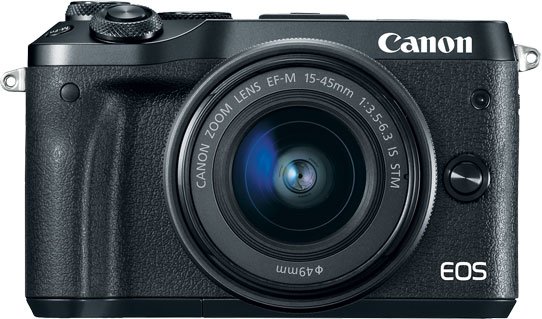
Who is the Canon EOS M6 for?
Photographers who shoot still subjects in low light settings will find Multi-shot Noise Reduction incredibly handy for preserving ambience. This includes architecture and street photography. The continuous drive frame rate is decent, making it good for action photographers as well. While beginners may be intimidated by the number of dials and functions it’s still a great camera to start with. Intermediate photographers will get a lot of mileage out of the M6 as well. And it is a wonderful second body for advanced photographers.
Conclusion
The Canon EOS M6 is a solid addition to Canon’s mirrorless camera line. It is a decent upgrade from the M3, but does not outclass the M3 entirely. The advanced, yet intuitive dial design and Combination IS help it stand out from the less expensive M100. And 24.2 megapixels, plus a large APS-C sensor, give it superior depth of field and noise control over anything except a full-frame sensor. However, the lack of an electronic viewfinder makes operating it a bit clumsy for more traditional photographers. And while it offers great features, the M6 has nothing unique except for Multishot Noise Reduction. Every other feature is offered by one or more of the other mirrorless brands. And many of those brands do a much better job; image stabilization being a key example.
With the EF-EOS M adapter, the M6 is an excellent walk-around camera for the Canon user looking for a second camera body. The M adapter allows users that already have Canon EF and EF-S lenses to use them with the EOS-M mount of the M6. No 4K video is also a bit disappointing, as 4K is more common in intermediate priced cameras. Overall, the EOS M6 is an acceptable mirrorless camera. But the mirrorless market is much more competitive than it was a few years ago. Canon’s whole mirrorless line needs a bit more attention if Canon wants to remain competitive in this market.

